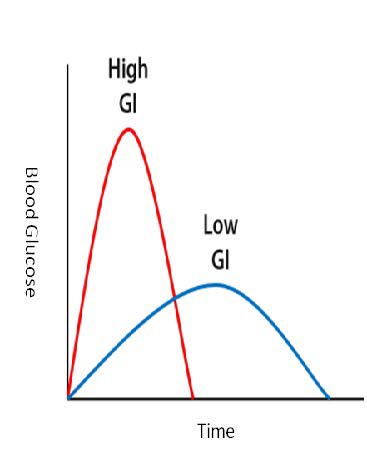All carbohydrate eaten will break down into glucose but not at the same rate and this will have different effects on your blood glucose (the sugar your body makes from the food you eat). The glycaemic index (GI) is a guide to how carbohydrate foods affect your blood glucose levels. The GI of glucose is 100 as it is absorbed rapidly.
A high GI food (more than 70) increases the blood glucose levels quickly for a shorter amount of time, whereas low GI food (less than 55) results in a slower and more prolonged rise in blood glucose level.

Two meals with the same carbohydrate content can affect your blood glucose levels differently depending on their GI. It is important to remember that not all low GI are healthy and not all high GI foods are unhealthy.
Low GI Examples:
Porridge oats, multigrain/seeded bread, basmati rice, sweet potatoes, pasta, lentils and pulses.
High GI Examples:
white bread, mashed potatoes, cornflakes, rice krispies, jam and fruit juice.
Often meal choices contain a combination of low GI and high GI foods where the overall effect may result in a medium GI. As well as GI there are several other factors which effect how quickly the carbohydrates you eat changes to glucose in your blood. This includes:
| Meal size |
large amount of any type of carbohydrate will take longer to digest than a smaller amount. You may find an advanced (split) bolus useful for meals over a certain size (consider meals over ______g). |
| Fat and protein |
Having high fat foods (oil, butter, cream, cheese etc.) and high protein foods (meat, fish, eggs etc.) as part of a meal, will slow down the rate of digestion therefore lowering the GI of the meal. |
| Fibre |
High fibre foods such as whole grain cereal or bread, fruit, vegetables, beans or pulses and potato skins, are digested very slowly and generally have a lower GI. |
| Processing |
A more processed food is likely to have a higher GI. For example, easy cook rice has a higher GI than basmati rice. Whole oats have a lower GI than instant porridge due to processing methods. |
Cooking
Method |
‘Al dente’ pasta will have a lower GI value when compared to overcooked pasta. |
| Ripeness |
Well ripened fruits will have a higher GI value as the sugar is more readily available. |





